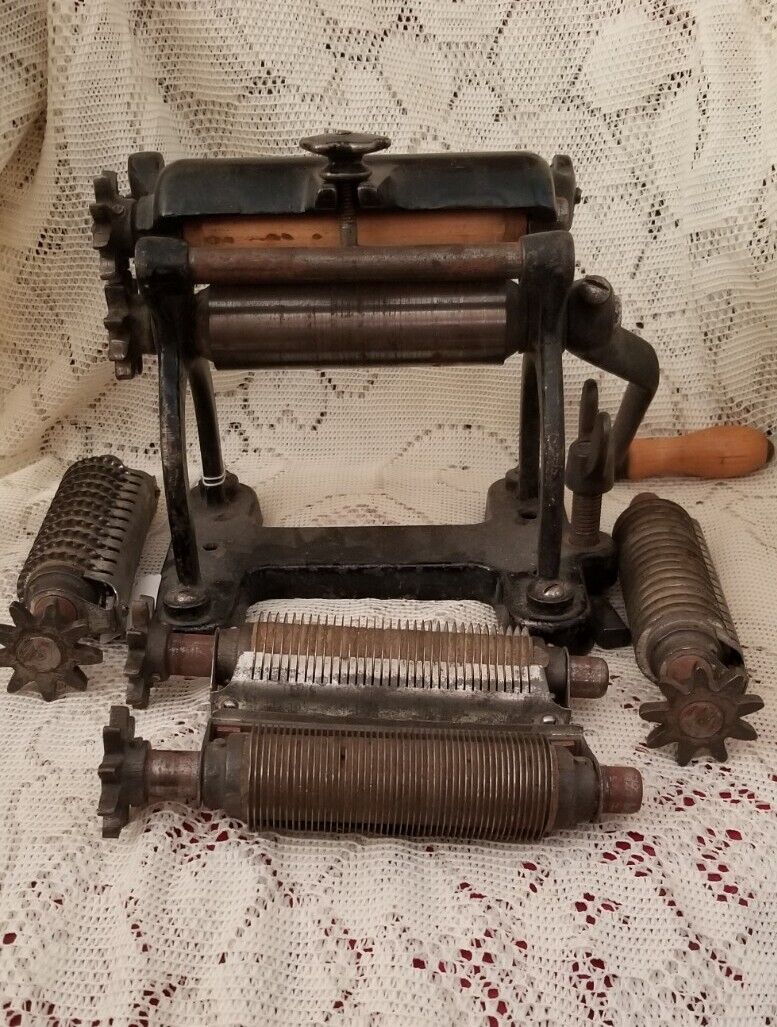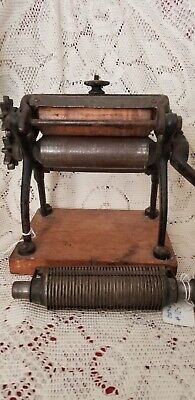The antique spaghetti or pasta maker is a remarkable artifact of culinary history, embodying both the craftsmanship and ingenuity of earlier food preparation techniques. Predominantly used from the late 19th to early 20th century, these machines were designed to transform homemade dough into perfectly shaped pasta, reflecting the importance of pasta in various culinary traditions.
Design and Materials:

Material: Antique pasta makers were typically constructed from robust materials such as cast iron, brass, or steel. Cast iron models often feature ornate detailing and were known for their durability and stability. Brass or steel components were prized for their strength and resistance to corrosion.
Structure: The design of these pasta makers generally includes a set of rollers and cutters. The rollers, often adjustable, flatten the dough into thin sheets, while the cutters shape the dough into various pasta forms, including spaghetti, fettuccine, or macaroni. Some models also feature a hand-crank mechanism that operates the rollers, showcasing a blend of function and craftsmanship.
Aesthetic Elements: Antique pasta makers often exhibit intricate detailing, such as ornate patterns or engraved designs, which highlight the artisanal quality of the machine. The craftsmanship and decorative elements reflect the period’s emphasis on both practicality and beauty in kitchen tools.
Functionality:

Purpose: The primary function of the antique pasta maker was to streamline the process of making pasta from scratch. By rolling and cutting dough with precision, the machine enabled home cooks to create consistent and high-quality pasta with ease.
Usage: To use the pasta maker, dough was first prepared and then fed through the rollers to achieve the desired thickness. Adjustments to the rollers allowed for varying thicknesses of dough. The pasta maker’s cutters then transformed the flattened dough into spaghetti, tagliatelle, or other pasta shapes, ready for cooking or drying.
Historical Significance:
Antique pasta makers offer a fascinating glimpse into the culinary practices of the past. They reflect a time when homemade pasta was a staple of daily life and a symbol of family and tradition. The evolution of these tools underscores the growing sophistication of kitchen technology and the enduring appeal of pasta in global cuisine.

Collectibility and Value:
Rarity: Well-preserved antique pasta makers, especially those with unique features or craftsmanship, are highly collectible. Their rarity and historical value make them sought-after items among enthusiasts and collectors of vintage kitchenware.
Condition: The value of an antique pasta maker is influenced by factors such as its material, design, and condition. Models that are complete, functional, and exhibit minimal wear typically command higher prices. Restoration can also impact value, though original, untouched examples are often more desirable.
The antique spaghetti or pasta maker is more than just a practical appliance; it is a piece of culinary history that showcases the artistry and innovation of past generations. Its design and functionality not only enhance our understanding of historical food preparation but also celebrate the enduring legacy of pasta-making traditions.

